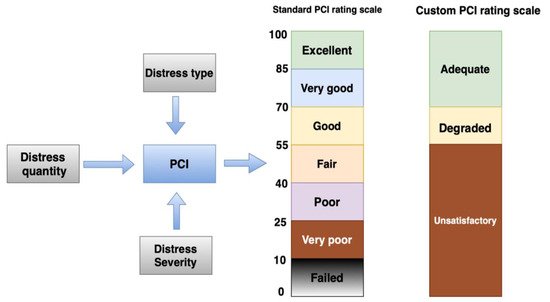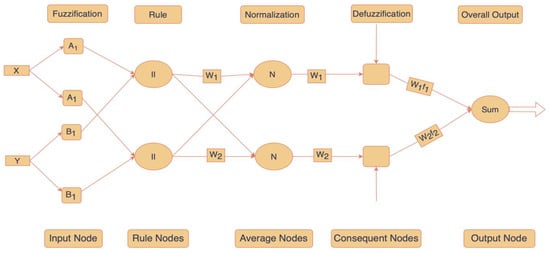You're using an outdated browser. Please upgrade to a modern browser for the best experience.
Please note this is a comparison between Version 1 by Abdualmtalab Abdualaziz Yeklef Ali and Version 2 by Sirius Huang.
The fuzzy logic technique is one of the effective approaches for evaluating flexible and rigid pavement distress. The process of classifying pavement distress is usually performed by visual inspection of the pavement surface or using data collected by automated distress measurement equipment. Fuzzy mathematics provides a convenient tool for incorporating subjective analysis, uncertainty in pavement condition index, and maintenance-needs assessment, and can greatly improve consistency and reduce subjectivity in this process.
- flexible pavements
- pavement condition index (PCI)
- fuzzy inference system (FIS)
- pavement distresses
1. Introduction
Pavements are considered the primary asset of road infrastructure in many countries. Pavement performance is measured using three indicators: the present serviceability rating (PSR), the pavement condition index (PCI), and the international roughness index (IRI). They are widely used in the development of pavement maintenance programs. The PCI is one of the most effective approaches to evaluating pavement performance. Pavement condition evaluation is conducted by visual inspection by personnel trained for that objective. Many agencies use conventional techniques to predict performance variables, but there are some drawbacks due to the time, large workforce, and equipment required to collect data from the field. Moreover, the amount of time needed for data input and model development is also of concern. Furthermore, subjectivity and inconsistency are significant problems in many highway agencies’ pavement distress evaluation processes.
The United States Army Corps of Engineers developed this technique. The PCI is calculated by visual inspection of a pavement and a numerical value between 0 and 100, with 0 representing a failed pavement and 100 representing the best possible conditions [1]. The standard PCI utilizes a scale of seven different classifications (excellent, very good, good… etc., to failed) to show different situations within the rankings, as demonstrated in Figure 1. Shahin and Walther [2] proposed the following method procedure for calculating PCI for flexible pavement:

Step 1: Determine the severity and extent of each type of distress for a pavement section. The severity level is expressed using three terms: Minimal, Moderate, and Severe. Depending on the type of distress, the extent is measured in linear, square (metre), or numbers.
Step 2: Determine the density of pavement distress by:
Step 3: Determine deduction points (DP) for each pavement distress type using deducting value curves.
Step 4: Calculate the total deduction value (TDV) for each section’s distresses.
Step 5: Calculate the corrected deduction value (CDV) to adjust the total deduction value (TDV).
Step 6: Subtract the CDV from 100 to calculate PCI for each section.
In recent decades, machine-based surveys have become an essential part of routine pavement condition evaluation because they provide the technology to collect surface distresses in a repeatable, detailed, and timely manner. However, the analysis method needs to be improved to efficiently convert these massive amounts of data into information. Due to advances in computational power, soft computing techniques have gained favour in pavement engineering in recent decades. The advanced computational and widely available resources for soft techniques enable the low-cost storage and handling of enormous data volumes. Soft computing, such as fuzzy logic and artificial intelligence, has recently been used in asphalt pavement to predict and classify pavement conditions.
These approaches are adaptable and can handle scenarios that engineers find unclear. Since engineering decisions necessitate a high level of human skill and must also be consistent, using soft computing in these situations is a good option for pavement engineers.
Numerous researchers have used new statistical and computational procedures to analyze and assess pavement conditions and recommend the most appropriate maintenance activity. Ahmed et al. [4] applied multiple linear regression techniques to develop the PCI.
Several studies examined pavement performance in terms of common distresses such as rutting and fatigue and methods for predicting pavement performance. For example, Mousa et al. used multi-layer elastic analysis software (KENLAYER) to predict the performance of constructed pavement with a base layer consisting of reclaimed asphalt pavement (RAP)/virgin aggregate blends, taking into account the horizontal tensile strain at the bottom of the AC layer and the vertical resilient strain at critical locations within the pavement system [5]. They calculated the total pavement rutting and fatigue cracking using the critical strains computed by the multi-layer elastic analysis and the performance models and transfer functions from the mechanistic-empirical pavement design guide.
Ali et al. [6] proposed a procedure for evaluating the pavement performance of 19 roads in St. John’s, Newfoundland, Canada, where the pavement condition index (PCI) and international roughness index (IRI) were the main indicators in the characterization of the overall pavement performance of asphalt pavement. Sagheer et al. [7] developed a knowledge-based technique for pavement distress categorization using logic programming and the Prolog language to assess distresses in flexible pavements.
Relatively few studies have been conducted in recent years to predict the PCI of flexible pavements using machine learning approaches [8][9][8,9]. Few studies have been shown to predict the PCI value based on artificial intelligence methods [10][11][12][10,11,12].
In the research of Imam et al. [13], IRI was the pavement condition indicator for predicting PCI using gene expression programming.
Piryonesi and El-Diraby [14] conducted a study to measure the accuracy of algorithms in predicting two of the most popular performance indicators, IRI and PCI, which use machine learning techniques to indicate asphalt pavement distress.
In 1965, Zadeh proposed the fuzzy set theory. Zadeh’s development of this approach primarily offered efficient solutions to complex problems. A model can incorporate quantitative (qualitative) and qualitative (quantitative) data with the fuzzy logic technique. Since its inception, fuzzy set theory has been applied to various fields, including civil engineering and others [15].
Moazami et al. [16] implemented the fuzzy logic for pavement maintenance and rehabilitation. Mahmood and Mahmood et al. [17][18][17,18] applied fuzzy logic theory for PCI models. In addition, Karashahin and Terzi [19] and Jeong et al. [20] used fuzzy logic technique to evaluate pavement performance and prediction models of pavement distress. All researchers mentioned above agreed that fuzzy modelling can handle a large number of pavement sections and provides more precise results than other soft computing techniques such as multiple linear regression, artificial neural networks, or other analytical processes.
The assessment of the influence of pavement distress variables on any pavement section at an individual level and prioritization for maintenance and rehabilitation (M&R) is a challenging task, particularly due to the difference in opinion of decision-makers. Therefore, it is desirable to devise a rating mechanism or condition indicator that would represent qualitative and quantitative measurements capturing the condition of the pavements.
2. Fuzzy Logic Approach
Several artificial intelligence technologies, including fuzzy logic and genetic algorithms, can predict various situations [21]. Zadeh introduced the fuzzy theory in 1965 with the perception of uncertainty and certainty, and it has numerous applications [22][23][24][22,23,24]. In the field of engineering, the fuzzy approach can be used to evaluate uncertain problems [25]. In recent decades, fuzzy logic has been widely used in electronic machines, such as washing machines, microwave ovens, and industrial process control [26]. The fuzzy logic set method is one of the accurate mathematical methods for modelling and simulating incomplete knowledge [27].
An approach to modelling based on fuzzy logic is more in line with the way humans think and demonstrates the ability to deal with ambiguity, subjectivity, and uncertainty. Fuzzy logic imparts mathematical knowledge and expertise to less-experienced engineers based on membership degree rather than on crisp membership of the classical binary logic. Researchers in pavement performance classification have frequently employed this technique.
3. Fuzzy Rule-Based System
A fuzzy inference rule-based system is among the most common techniques used to solve classification problems. Fuzzy inference is a process that interprets the values in the independent variables and assigns values to the output variables based on user-defined rules. Initially, this method’s advantages are that intelligence is expressed in the form of IF-THEN laws, making the reasoning process understandable in human terms. Meanwhile, it would have the ability to take linguistic information from human analysts and combine it with numerical data. Lastly, it can approximate complex nonlinear functions with a simple method. Figure 2 presents the diagram of a fuzzy inference system.

Figure 2. Schematic diagram of a fuzzy inference system.
